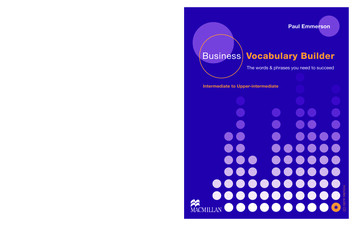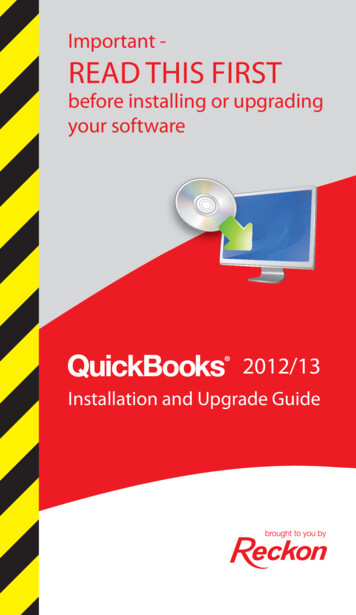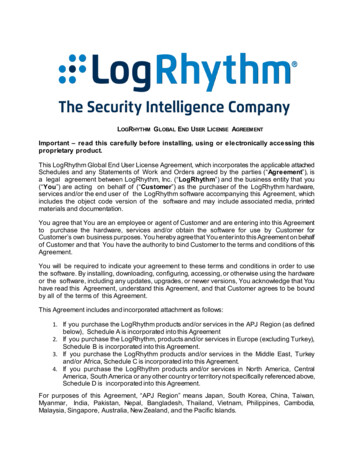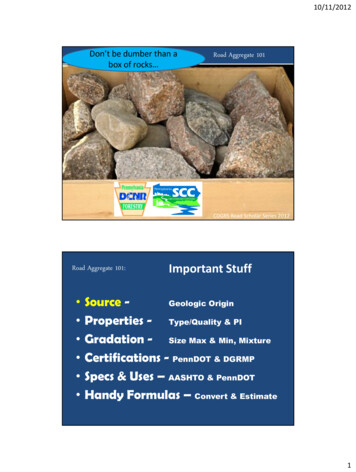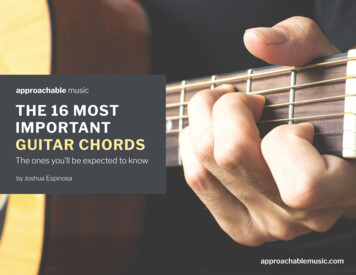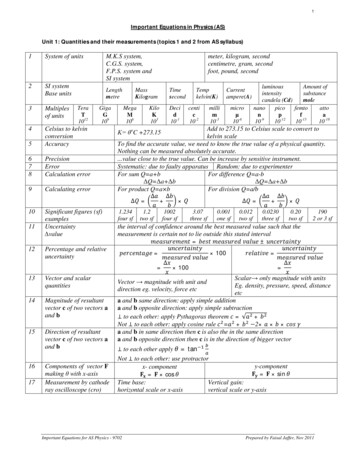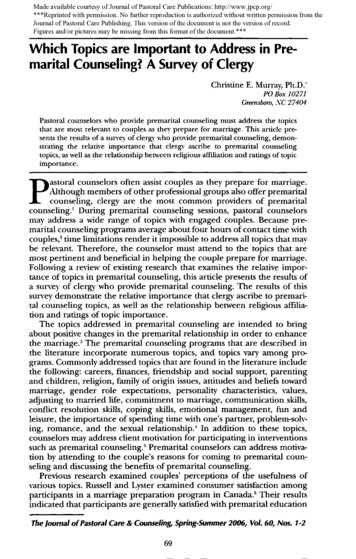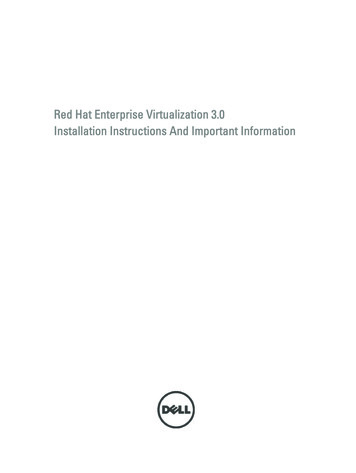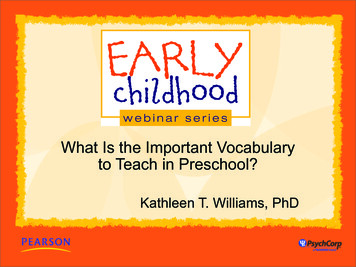
Transcription
What Is the Important Vocabularyto Teach in Preschool?Kathleen T. Williams, PhD
Snapshot of Speaker Began professional life as a second grade teacherin 1968 Involved in test and instructional materialdevelopment since 1989 Has been a speech pathologist, classroom teacher,school psychologist, graduate & undergraduateinstructor Author of EVT-2, GRA DE, G MADE, RLI, & MLI Has a BS in speech pathology, MEd in elementaryeducation, MA in educational psychology, and PhDin school psychology
Overview Importance of vocabulary How vocabulary impacts literacydevelopment Categories of important words 3-steps to verbal learning Suggested activities
Vocabulary & Literacy Meaningful Differences in the Everyday Experienceof Young American Children– Hart & Risley (1995)– 2 ½ year study of professional & welfare families– In one year a child with professional parents will hear 11million words and a child in a welfare family will hear just3 million words.– Longitudinal research demonstrated that early differencesnoted in children entering school remain static throughouttheir education
The more words you know, the moreyou can read The more you read, the more wordsyou will learn For children starting school with alimited vocabulary, “more” readingdoes not result in “more” vocabulary(Stanovich, 1986)
Pre-alphabetic Stage 1st stage of reading & spellingdevelopment– Don’t understand that letters representsounds in words– Do know that print represents spokenmessages– Can remember words by visualappearance– Don’t know the alphabetic principle
Early Alphabetic Stage Do know letters correspond to the sounds that make upspoken words (the alphabetic principle) Growing awareness of speech sounds and knowledgeof letter forms– Attempt to “read” words by guessing from initialconsonant & context– Spell by writing a few consonants & leaving out lessdistinct sounds– Beginning to demonstrate awareness of phonemesand the use of the alphabet to represent them
Later Alphabetic Reading &Writing Gradual development of skill atsounding out words and spelling themphonetically– Ability to identify all speech sounds in aword and match to letters– Awareness of letter sequences &orthographic patterns
Emergent Literacy Skills Rhyming, rhyming, rhymingSound matching with initial consonantsAuditory recognition of syllablesModel correct syntactic patterns
The Importance of SyntacticAwareness Dialogue– Nouns label– Verbs tell action– Adjectives & adverbs describe
Important Word Categories Labeling: Nouns– Household objects & food items– Body parts– Common domesticated & wild animals Actions: Verbs Attributes: Adjectives & Adverbs– Basic numbers & colors Basic concepts & prepositions
The 25 most frequent words make upabout one-third of all print material. Top 25: yhavetoitareIfrom
Prepositions in the Top 25: yhavetoitareIfrom
3 Steps to Verbal Learning Verbal Learning: Gaininginformation from the spoken orwritten word
3-Steps to Verbal Learning Step One: Paying attention Step Two: Encoding–Putting new information into personally meaningful form Not just “in your own words” Actively processing information individually or withpeers Step Three: Linking the new information towhat you already know–To move from immediate memory into long-termmemory
Vocabulary Instruction Steps1 Introduce new word.2 Link: Integrates new information withprior knowledge.3 Rehearse: Facilitates reexposure towords.4 Practice: Provides opportunities formeaningful use.
Vocabulary Development in Natural Contexts Matching perception - What is this? Analysis of perception - Show 4 pictures;Which one cries? Reordering Perception - Show 4 pictures;Tell me the name of the one that is not ananimal. Reasoning about Perception - What madethe milk fall off the table?
Pivotal Early Childhood Themes:Provide Natural Context for VocabularyDevelopment AnimalsWeatherSelf-esteemFamily Holidays World Cultures Community
Basic Conceptual Words Form the functional vocabulary of earlylearning experiences– Following directions– Describing an object– Understanding spatial relationships 30% of the 220 high-frequency words– Dolch Basic Sight Word List
Basic Conceptual Words Direction (up, down)Position (inside, outside)Size (large, big, little, small)Comparison (longer, shorter)Texture (smooth, rough)Quantity (many, few)Shapes (star, circle, triangle)
Developing Conceptual Words Cut cardboard tubes into graduated lengths.– Longest, tallest, shortest, identical, nearest, etc. Use toys from fast-food restaurants for teachingposition– Over, on, above, next, etc. Empty egg cartons & dry cereal pieces canillustrate quantity & numerical concepts.– More, less, some, none, few, many, same, etc.– One, two, three, etc.
Labeling Activities for Young Children Outline the shape of simple objects– Child must match objects to shape (in one try) andname it Using grocery and discount store flyers, createseparate posters– Things that go in the kitchen, the bath, thebedroom, the garage, etc Have child sort various buttons in an empty egg carton– Ask child why buttons are sorted the way they are
Vocabulary-Building in Natural Contexts Read or tell stories– Ask questions– Ask for a different word– Ask student to retell story– Demonstrate how the context of the story can explainthe meaning of an unknown word Tell jokes or tall tales.– Why is it funny? Unusual? Odd?– Retell changing a key word
Reading Aloud Why:– Develops background knowledge– Builds vocabulary– Increases familiarity with language patterns– Develops familiarity with story structure– Develops print awareness– Models fluency, prosody, appropriate emotion– Helps to view reading as pleasurable
References & Resources Beck, I.L., McKeown, M.G., & Kucan, L. (2002).Bringing words to life. Robust vocabulary instruction.New York: Guilford Press. Cummins, J. (1980). The construct of languageproficiency in bilingual education. In J.E. Alatis (Ed.),Georgetown University roundtable on languages andlinguistics. (pp. 76-93). Washington, DC: GeorgetownUniversity Press. Cultivating Readers: Making Reading Active and Fun!See www.famlit.org
References & Resources Fry, E. B., Kress, J. E., & Fountoukidis, D. L. (2006).The reading teacher’s book of lists (5th ed.).Paramus, NJ: Prentice Hall. Moats, L.C. (2000). Speech to print. Baltimore, MD:Paul H. Brookes Publishing Co. National Institute for Literacy. (2008). DevelopingEarly Literacy: Report of the National Early LiteracyPanel: A scientific synthesis of early literacydevelopment and implications for intervention.Jessup, MD. [Download the document atwww.nifl.gov]
References & Resources Snow, C.E., Burns, M.S., & Griffin, P. (Eds.). (1998).Preventing reading difficulties in young children.Washington, DC: National Academy Press. Stanovich, K.E. (1986). Matthew effects in reading:Some consequences of individual differences in theacquisition of literacy. Reading Research Quarterly, 21,360-407. Taylor, S.E., Frankenpohl, H., White, C.E., Nieroroda,B. W., Browning, C,.L., & Birsner, E.P. (1989). EDLcore vocabularies in reading, mathematics, science,and social studies. Columbia, SC: EducationalDevelopmental Laboratories.
Questions?dr.kathleenwilliams@gmail.com
–Putting new information into personally meaningful form Not just “in your own words” Actively processing information individually or with peers Step Three: Linking the new information to what you already know –To move from immediate memory into long-term memory. Vocabulary Instruction Steps 1 Introduce new word. 2 Link: Integrates new information with prior knowledge. 3 .
